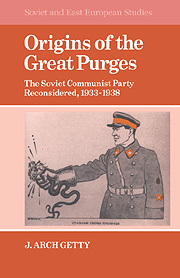Book contents
- Frontmatter
- Contents
- List of tables
- Preface
- Introduction: the Great Purges as history
- 1 The Communist Party in the thirties
- 2 What was a purge?
- 3 The Verification of Party Documents of 1935: a case study in bureaucratic ineptitude
- 4 Radicalism and party revival
- 5 Radicalism and enemies of the people
- 6 The crisis matures: 1937
- 7 Epilogue: the Ezhovshchina
- Conclusion: some observations on politics in the thirties
- Appendix: the Kirov assassination
- Bibliographic essay
- Notes
- Index
- SOVIET AND EAST EUROPEAN STUDIES
7 - Epilogue: the Ezhovshchina
Published online by Cambridge University Press: 23 September 2009
- Frontmatter
- Contents
- List of tables
- Preface
- Introduction: the Great Purges as history
- 1 The Communist Party in the thirties
- 2 What was a purge?
- 3 The Verification of Party Documents of 1935: a case study in bureaucratic ineptitude
- 4 Radicalism and party revival
- 5 Radicalism and enemies of the people
- 6 The crisis matures: 1937
- 7 Epilogue: the Ezhovshchina
- Conclusion: some observations on politics in the thirties
- Appendix: the Kirov assassination
- Bibliographic essay
- Notes
- Index
- SOVIET AND EAST EUROPEAN STUDIES
Summary
Ils sauront bientôt que nos balles
Sont pour nos propres généraux.
“The Internationale”Unfortunately, continuous archival coverage of local events in the Western Region ends in the middle of 1937. After that time, it becomes very difficult to trace the interplay of central and peripheral forces, and knowledge of the period of the Ezhovshchina must remain sketchy and incomplete. In the absence of other sources, one must rely on the press and fall back upon the older methods of Kremlinology and text analysis in an attempt to piece together events, disputes, and policy changes relating to the center–periphery struggle. Interpretation of events from late 1937 through 1938 must therefore be hypothetical and incomplete. Despite the essentially speculative nature of any analysis of the politics of the post-1937 period, certain patterns emerge that suggest the contours of the Ezhovshchina.
Observations on incidence
The Ezhovshchina was a maelstrom of political violence that involved all bureaucratic factions and interest groups. Stalin used police repression of “enemies of the people” to settle old scores and to destroy anyone he chose. Others in the Moscow leadership turned the police tool to their own advantage as well. Kaganovich used terror to sweep transportation agencies of those he mistrusted. When he took over the Commissariat of Foreign Affairs, Molotov used the police weapon to wipe out the clients of former commissar Maksim Litvinov. In fact, through denunciations to the police or to Stalin, any leader could use the vigilance campaign to destroy members of rival groups. Even officials who would soon be arrested as “enemies” were able to secure their opponents' arrest.
- Type
- Chapter
- Information
- Origins of the Great PurgesThe Soviet Communist Party Reconsidered, 1933–1938, pp. 172 - 195Publisher: Cambridge University PressPrint publication year: 1985



